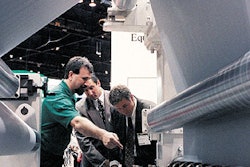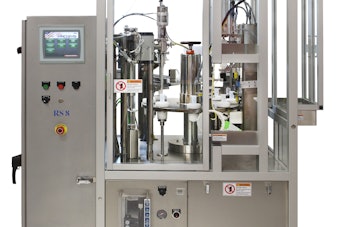Consumers covet convenience. So it should come as no surprise that this year’s DuPont Award winners for innovation in food processing and packaging are brimming with convenience features. (See page 34 for more DuPont Award winners.)
A perfect example is the all-plastic microwavable bowl (1) for the Kid’s Kitchen line of products from Austin, MN-based Hormel. In the photo shown here, the all-plastic bowl is on the left and its predecessor is on the right.
These microwavable meals in barrier cups have been around since ’89. Yet a dramatic upgrade the past year to an all-plastic structure pushes these meals-in-bowls to the technology forefront. DuPont judges were so impressed, they named this package the winner of the competition’s top prize: the Diamond Award.
The new packaging was introduced in the southeast U.S. last year as the first wave of a national rollout. New is the plastic PolyStar® 37/16’’ dia end from Silgan’s OmniStar division (Norwalk, CT). Spin-welded to the container body, it replaces a seamed-on easy-open aluminum pull-tab end. The OmniStar end is supplied as a single piece comprising an integrated lid and rim. The 20-mil, seven-layer coextruded lidstock portion is polypropylene/PP and oxygen absorber blend/adhesive/ethylene vinyl alcohol /adhesive/PP with O2 absorber/PP, according to William Heyn, OmniStar general manager. A disc of that material is punched from a sheet and the rim is insert injection molded to the disc, Heyn explains. The rim is a compound of PP, polyolefins, and oxygen absorber. The lid has a handy ring tab for easy removal by consumers. Heyn says the cost of the all-plastic end is competitive with aluminum ends.
The five layers in the co-injection blow molded OmniBowl®, from OmniStar, remain unchanged: A blend of PP and high-density polyethylene/adhesive with desiccant/EVOH/ adhesive with desiccant/PP-HDPE blend. A foam insulating label printed with graphics and an HDPE overcap complete the packaging. Hormel says the product shelf life remains at 18 months.
At Hormel’s Beloit, WI, plant, a first-of-a-kind, 16-station PolyWeld® unit from OmniStar spin-welds the ends at a rate of 400/min prior to retorting. The end is applied and then spun at 1000 RPM via servomotor onto the bowl. Friction melts the plastic to seal the rim to the bowl’s flange. The process is closely monitored automatically, and containers not meeting preset conditions are rejected. The PolyWeld is built by Philips Enabling Technologies (Plainfield, NJ).
The packaging is a winner with consumers, too. Consumer feedback for the all-plastic bowls has been “overwhelmingly positive,” according to Hormel product manager Cris Eide. Eide says consumers appreciate that the packages are easier to open, safer for kids to use, and create less spill/splatter when opening than before. “Eighty-five percent of consumer compliments have been specifically about the [new] container,” he points out. “Food compliments are typically reserved for the actual product or taste.”
“Transparent” carton kit for eggs
Winning silver in the food category was Eggs & More® (2) from Eggland’s Best, King of Prussia, PA. It’s a kit-style concept that combines fresh eggs with the key components needed to prepare such delicacies as eggs benedict or deviled eggs. All these components fit appealingly in patented tri-fold cartons thermoformed of clear recycled polyethylene terephthalate by Advanced Engineering (Beaverton, MI) using 15-mil RPET rollstock. The clear packages match the shape of traditional 6- or 12-count egg cartons to fit seamlessly into normal egg distribution channels, notes Eggland’s Charles Lanktree, president/CEO. A middle cavity between one or two pairs of eggs holds the components, such as English muffins, Canadian bacon or sliced cheese, which are provided by companies like Sargento and Hormel.
“This is a packaging-led product that extends the convenience of our eggs,” Lanktree says. Graphics designed by Dixon & Parcels (New York, NY) are printed flexographically by Printing Arts (Grand Rapids, MI) on 100# C2S paper sheet inserts. The kits are packed by egg producer Herbruck Poultry Farm, Saranac, MI.
Introduced in test in Grand Rapids, MI, in Fall ’99, Eggs & More was a way to boost the sale of the nutritionally enhanced Eggland’s Best eggs using convenient packages, says Lanktree. His company is a franchisor of egg farms in 37 states licensed to use the Eggland’s Best name, which is printed as “EB” on each egg. Refrigerated product shelf life is limited by that of the eggs, which in Michigan is 40 days.
Eggs & More has been unavailable since late ’00 when the market test was completed. Herbruck president Steve Herbruck expects Eggs & More to reappear in a market other than Grand Rapids—and likely not in Michigan—by year’s end. Ahead of the reintroduction, the companies involved are reassessing aspects ranging from ingredients to advertising, notes Lanktree. “We may make some modifications, and may not reintroduce all five items, but we won’t adjust the packaging other than to make [minor] graphic adjustments.”
Enviropackaging
Judges were impressed with the Soft Cartridge (3) largely because of its environmental advantages. It first appeared on store shelves in Japan in 1999 when manufacturers of building materials began using it for their caulking products. Hosokawa Yoko (Tokyo, Japan) developed the cartridge technology and manufactures the cartridges. Assisting in development and sales is Polymer Systems (Kawasaki, Japan).
According to Ito Masahiro of Hosokawa Yoko, the Soft Cartridge is about 15% less expensive than a composite paper/foil cartridge and is priced competitively with a plastic rigid cartridge. Perhaps more important, when emptied this package is said to occupy only 12% of the space occupied by a conventional container. That’s because when contents are dispensed, the flexible container is easily compressed.
The cartridge is a four-layer adhesive lamination typically consisting of linear low-density polyethylene/polyester/aluminum foil/LLDPE. The polyester layer is printed in up to 10 colors on a gravure press.
Hosokawa Yoko cuts individual pieces of the multilayer material from rollstock and forms them into sleeves. In a third station, sleeves are enclosed in molds and PE is injection molded onto each end of the sleeve to give it a top and a bottom. The top has a hole through which caulk can be filled at the customer’s plant. After filling by the customer on what Hosokawa Yoko calls “existing equipment,” an injection-molded plastic top is applied. Users of the caulk remove this lid and insert the cartridge into a dispensing gun.
Hosokawa Yoko claims that its cartridge-making equipment has sixteen cavities and is capable of producing 24 cartridges/min. Sizes range from 120- to 600-mL (40- to 200-oz).




















